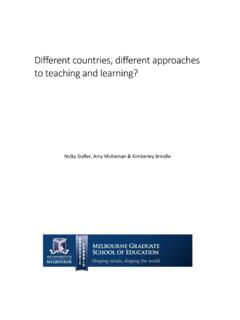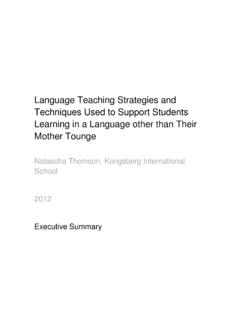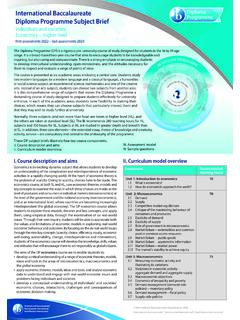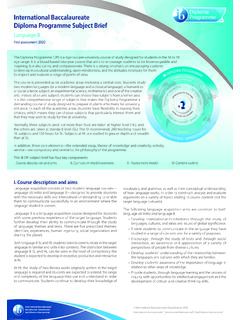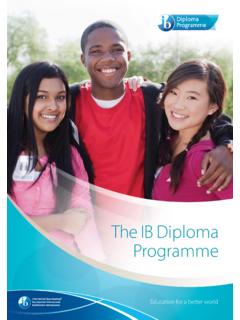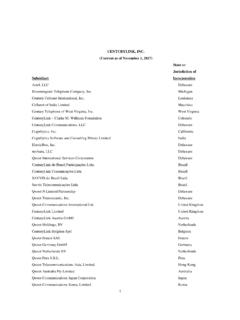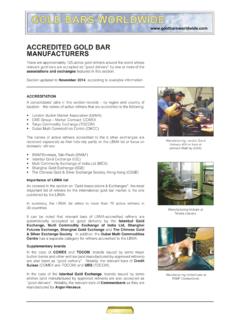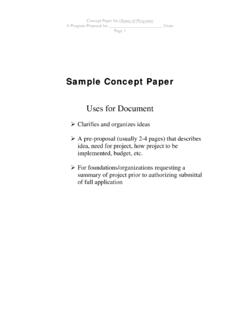Transcription of Grade descriptors - International education
1 Grade descriptorsFor use from December 2017 Grade descriptorsFor use from December 2017 Published December 2017 Published on behalf of the International Baccalaureate Organization, a not-for-profit educational foundation of 15 Route des Morillons, 1218 Le Grand-Saconnex, Geneva, Switzerland by theInternational Baccalaureate Organization (UK) Ltd Peterson House, Malthouse Avenue, Cardiff Gate Cardiff, Wales CF23 8GL United Kingdom Website: International Baccalaureate Organization 2017 The International Baccalaureate Organization (known as the IB) offers four high-quality and challenging educational programmes for a worldwide community of schools, aiming to create a better, more peaceful world. This publication is one of a range of materials produced to support these IB may use a variety of sources in its work and checks information to verify accuracy and authenticity, particularly when using community-based knowledge sources such as Wikipedia.
2 The IB respects the principles of intellectual property and makes strenuous efforts to identify and obtain permission before publication from rights holders of all copyright material used. The IB is grateful for permissions received for material used in this publication and will be pleased to correct any errors or omissions at the earliest rights reserved. No part of this publication may be reproduced, stored in a retrieval system, or transmitted, in any form or by any means, without the prior written permission of the IB, or as expressly permitted by law or by the IB s own rules and policy. See merchandise and publications can be purchased through the IB store at : ProgrammeGrade descriptorsInternational Baccalaureate, Baccalaur at International and Bachillerato Internacional and IB logos are registered trademarks of the International Baccalaureate mission statementThe International Baccalaureate aims to develop inquiring, knowledgeable and caring young people who help to create a better and more peaceful world through intercultural understanding and this end the organization works with schools, governments and International organizations to develop challenging programmes of International education and rigorous programmes encourage students across the world to become active, compassionate and lifelong learners who understand that other people, with their differences, can also be descriptorsixContentsIntroduction 1 group 1 (studies in language and literature)
3 Grade descriptors 2 group 2 (language acquisition) Grade descriptors 4 group 3 (individuals and societies) Grade descriptors 10 group 4 (sciences) Grade descriptors 12 group 5 (mathematics) Grade descriptors 16 group 6 (arts) Grade descriptors 18 Interdisciplinary subjects Grade descriptors 20 Extended essay Grade descriptors 24 Theory of knowledge Grade descriptors 26 Grade descriptors11 Diploma ProgrammeIntroductionThis document is a compilation of descriptions ( Grade descriptors ) of each Grade for each group of subjects in the IB Diploma Programme. Grade descriptors consist of characteristics of performance at each Grade . The descriptors apply to groups of subjects but substantial similarity exists across sets of group Grade examiners use these Grade descriptors when determining Grade boundaries for examination papers and coursework components.
4 For each Grade , qualities of a typical performance are given. However, the work of few candidates will be consistently characterised by a single Grade descriptor , most work will display some of the characteristics of more than one Grade . Senior examiners therefore review the work of many candidates to determine a Grade boundary the lowest mark at which characteristics of a Grade are consistently shown in candidate work allowing for some compensation across the different Grade descriptors are also intended to help teachers explain the academic requirements of the IB Diploma Programme to students, undertake formative assessment, report progress and predict candidates descriptors2 group 1 (studies in language and literature) Grade descriptorsStudies in language and literatureGrade 7 Demonstrates: excellent understanding and appreciation of the interplay between form and content in regard to the question or task; responses that may be convincing, detailed, independent in analysis, synthesis and evaluation; highly developed levels of expression, both orally and in writing.
5 Very good degree of accuracy and clarity; very good awareness of context and appreciation of the effect on the audience/reader; very effective structure with relevant textual detail to support a critical engagement with the thoughts and feelings expressed in the work(s). Grade 6 Demonstrates: very good understanding and appreciation of the interplay between form and content in regard to the question or task; responses that are, mainly, convincing, as well as detailed and independent to some degree, in analysis, synthesis and evaluation; well-developed levels of expression, both orally and in writing; good degree of accuracy and clarity; good awareness of context and appreciation of the effect on the audience/reader; effective structure with relevant textual detail to support a critical engagement with the thoughts and feelings expressed in the work(s).
6 Grade 5 Demonstrates: good understanding and appreciation of the interplay between form and content in regard to the question or task; responses that offer generally considered and valid analysis, synthesis and/or evaluation; good levels of expression, both orally and in writing; adequate degree of accuracy and clarity; awareness of context and appreciation of the effect on the audience/reader; clear structure with relevant textual detail to support an engagement with the thoughts and feelings expressed in the work(s). Grade 4 Demonstrates: adequate knowledge and understanding of the question or task; responses that are generally valid in analysis and/or synthesis; satisfactory powers of expression, both orally and in writing; few lapses in accuracy and clarity; some awareness of context and appreciation of the effect on the audience/reader; a basic structure within which the thoughts and feelings of the work(s) are 3 Demonstrates: some knowledge and some understanding of the question or task; responses that are only sometimes valid and/or appropriately detailed; some appropriate powers of expression, both orally and in writing; lapses in accuracy and clarity; limited awareness of context and appreciation of the effect on the audience/reader.
7 Some evidence of a structure within which the thoughts and feelings of the work(s) are 2 Demonstrates: superficial knowledge and understanding of the question or task; responses that are of generally limited validity; limited powers of expression, both orally and in writing; significant lapses in group 1 (studies in language and literature) Grade descriptorsGrade descriptors3accuracy and clarity; little awareness of context and appreciation of the effect on the audience/reader; rudimentary structure within which the thoughts and feelings of the work(s) are 1 Demonstrates: very rudimentary knowledge and understanding of the question or task; responses that are of very limited validity; very limited powers of expression, both orally and in writing; widespread lapses in accuracy and clarity; no awareness of context and appreciation of the effect on the audience/reader; very rudimentary structure within which the thoughts and feelings of the work(s) are descriptors4 group 2 (language acquisition) Grade descriptorsLanguage B (HL) Grade 7 Students speak with clarity and fluency; use a richly varied and idiomatic range of language very accurately; handle ideas effectively and skillfully with active and complex interaction; demonstrate a thorough understanding of the meaning and purpose of written texts; have little difficulty with the most difficult questions; recognize almost all the subtleties of specific language usage; write detailed and expressive texts demonstrating an excellent command of vocabulary and complex structures with a consistently high level of grammatical accuracy.
8 Demonstrate clarity of thought in the organization of their work and an ability to engage, convince and influence the 6 Students speak clearly, fluently and naturally; use a varied and idiomatic range of language accurately; handle ideas effectively with active and full interaction; demonstrate a very good understanding of the meaning and purpose of written texts; have little difficulty with more difficult questions; recognize most of the subtleties of specific language usage; write detailed texts demonstrating a very good command of vocabulary and complex structures with a very good level of grammatical accuracy; adapt their writing appropriately to suit the intended audience and purpose; express their ideas and organize their work coherently and 5 Students speak mostly clearly and fluently; use a varied range of language mostly accurately; handle ideas mostly effectively with generally full interaction; demonstrate a good understanding of the meaning and purpose of written texts; have some difficulties with more difficult questions; recognize some subtleties of specific language usage; write fairly detailed texts demonstrating a good command of vocabulary with a good level of grammatical accuracy; show a reasonable ability to adapt their writing to suit the intended audience and purpose; express their ideas and organize their work 4 Students speak generally clearly; use a basic range of language correctly; handle ideas adequately with full interaction at times; demonstrate an adequate understanding of the meaning and purpose of written texts; have some difficulties with almost all difficult questions and some average questions.
9 Recognize a few subtleties of specific language usage; write texts demonstrating an adequate command of vocabulary with an adequate level of grammatical accuracy; show some ability to adapt their writing to suit the intended audience and purpose; express their ideas and organize their work 3 Students speak hesitantly and at times unclearly; use a simple range of language correctly at times; handle ideas with some difficulty with fairly limited interaction; demonstrate some understanding of the meaning and purpose of written texts; have difficulties with questions of average difficulty; write texts demonstrating a basic command of vocabulary and some awareness of grammatical structure; produce an identifiable text type; make some attempt at expressing their ideas and organizing their 2 (language acquisition) Grade descriptorsGrade descriptors5 Grade 2 Students speak hesitantly and generally unclearly; use a limited range of language often incorrectly; handle ideas with difficulty and with restricted interaction; demonstrate a fairly limited understanding of the meaning and purpose of written texts; have difficulties with some easy questions; write texts demonstrating a fairly limited command of vocabulary and little awareness of grammatical structure; produce an identifiable text type with limited success; make some attempt at basic organization; content is rarely 1 Students speak hesitantly and unclearly; use a very limited range of language mostly incorrectly; handle ideas with great difficulty and with very restricted interaction.
10 Demonstrate a limited understanding of the meaning and purpose of written texts; have difficulties even with easiest questions; write texts demonstrating a limited command of vocabulary and little awareness of grammatical structure; produce a barely identifiable text type; lack organization to an extent that content is B (SL) Grade 7 Students speak clearly, fluently and naturally; use a varied and idiomatic range of language accurately; handle ideas effectively with active and full interaction; demonstrate a very good understanding of the meaning and purpose of written texts; have little difficulty with more difficult questions; write detailed texts demonstrating a very good command of vocabulary and complex structures with a very good level of grammatical accuracy; adapt their writing effectively to suit the intended audience and purpose; express their ideas and organize their work coherently and 6 Students speak mostly clearly and fluently; use a varied range of language mostly accurately; handle ideas mostly effectively, with generally full interaction; demonstrate a good understanding of the meaning and purpose of written texts; have some difficulties with more difficult questions; write fairly detailed texts demonstrating a good command of vocabulary with a good level of grammatical accuracy; adapt their writing appropriately to suit the intended audience and purpose; express their ideas a
